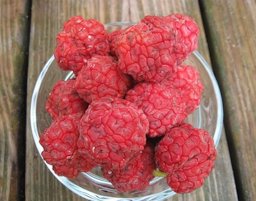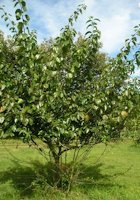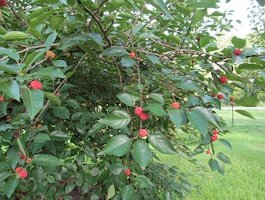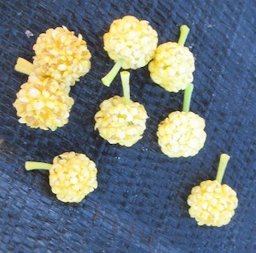Fact Sheet from
the Just Fruits and Exotics Nursery
by Brandy Cowley Gilbert
Melonberry
Cudranis
tricuspidata

Mandarin melon berry fruit
Mandarin Melonberry (Cudrania tricuspidata)
is
a beautiful, small rounded tree with broad green olive leaves.
It’s also called Che or Chinese mulberry and is a member of
the mulberry family. The tree flowers in mid spring and the fruit
matures in mid summer. The fruit looks like a large, round raspberry,
with a few seeds; the taste has a distinct cantaloupe-like flavor. Use
fresh in fruit salad or eat out of hand. Mandarin Melonberry is one of
the easiest, most problem-free fruits you can grow – a little
care will go a long way with this tree. Female trees will fruit by
themselves (ours did!). If you want to increase fruit yield you may
want to add a male che later. Two types of trees are available. We
graft some trees onto Osage orange rootstock to ensure early, heavy
fruit production without root suckering. Cutting-grown trees are also
available – these will spread into a hedge, but root suckers
will be thornless.
Uses in the
Landscape
Mandarin melonberry grow to approximately 30 feet tall. Trees can be
allowed to grow into large fruiting shade trees or pruned into a
smaller bush. Use as a small specimen tree or mix in with apples,
peaches and plums for months of fresh fruit.
 |
 |
| Mandarin melonberry female Norris tree |
Planting and
Culture
Site Selection
Well-drained sandy soils are preferred, but
mandarin melonberry will
grow on many soil types if good drainage is provided. Trees do not
tolerate flooding. Trees will grow more vigorously and produce more
fruit in full sun. Because space is usually limited, savvy gardeners
have planted the male and female che in the same hole. The male is kept
pruned to about ¼ of the total canopy for adequate
pollination and best fruit production (see below for pruning tips).
Soil
Preparation and Planting
Mandarin Melonberry prefers slightly acid soil
(pH 6.0-6.5), but soils
of up to moderate alkalinity are readily tolerated. If you are in doubt
about the acidity of your soil, take a soil sample to the Cooperative
Extension Agent in your county for a soil test.
Dig a planting hole approximately three times the width of the pot and
at the same depth as the root ball. Set that soil aside and mix it
50/50 with either aged mushroom compost, aged manure, or rotted pine
bark & aged manure/compost. Remove the plant from the pot,
gently loosen the root ball and place in the planting hole. To avoid
burying too deep, make sure plant is positioned with the top most roots
at the soil line. Fill the planting hole with the mix of soil and
organic matter; gently tamp it in. Water thoroughly to settle the roots
and eliminate air pockets. Do NOT put fertilizer in the planting hole.
Only apply fertilizer if it is the correct time of year (see
Fertilization section below).
If desired, construct a water basin around the base of the tree
approximately 36 inches in diameter. Mulch in spring and summer with
approximately 4-6 inches of mulch. Pull mulch a couple of inches away
from the trunk for good air circulation. Grafted trees should be
planted on 20-foot centers. Non-grafted plants for hedgerows should be
set 6 feet apart.
Fertilization
The type of fertilizer you choose may be
chemical or organic. Make sure
that the fertilizer contains iron, zinc, manganese, magnesium,
molybdenum, copper and boron. These minor elements are very important
to plants and most soils are low in these elements. Application rates
vary according to age of plant. See chart below.
10-10-10 or 10-0-10
with minerals |
1
cup per each year of tree’s life
- Max out at 9 cups for Mature tree |
Espoma
Citrus Tone
(Organic) |
6
cups for 1 year old
10 cups for 2 year old (4-6ft)
18 cups for 7-9ft tree
24 cups for tree over 9ft |
Spread the fertilizer evenly under the entire canopy of the plant
avoiding a 5-inch area around the trunk. Water or rake in. For Zones
8a-10, fertilize 3 times each year in February, May and late July/early
August. For plants further north (Zones 6-7), fertilize 2 times each
year in March and June/July. Never fertilize after August (July in
Zones 6-7) as this will promote new growth late in the year
which will be subject to freeze damage.
Water
The first year is a critical time for the
establishment of a new tree.
Water thoroughly twice a week on light soils and once a week on clay
soils. Soak the entire root system deeply – this usually
takes 40-50 minutes. Mandarin Melonberry should receive at least 1 inch
of water each week for best growth and fruit production. Water
regularly, especially during dry periods. Fruit may drop prematurely if
insufficiently irrigated during dry spells.
Pollination
Male Mandarin Melonberry Tree He’s the Pollinator!
No
fruit is produced by the Male but without his flowers the Female
won’t fruit. The Male will cause seeds to be produced in the
fruit of any Female Melonberry variety within pollination range. If you
have a Female Melonberry that isn’t producing well or drops all
its fruit, and you don’t mind seeds in the fruit, then plant a
Male Melonberry within 15-20ft of the Female.

Darrow Mandarin melonberry fruit
Pruning and
Care
Trees fruit on the current year’s wood. Prune
heavily in
winter to encourage new growth for best fruit production. Remove
approximately half the branches formed the previous year and head back
remaining shoots by about half. If the male and female have been
planted together, keep the male to about 25% of the total canopy. This
may entail addition summer pruning of the male. The trees can be
allowed to reach full height or kept smaller for ease of harvest.
Mandarin melonberry appears to be free of pests and diseases.
Harvest
Fruit should be allowed to thoroughly ripen on
the tree for best
quality and flavor. You’ll know the fruit is ripe when the
stem doesn’t bleed white sap after picking.
Back
to
Che Page
|
|



